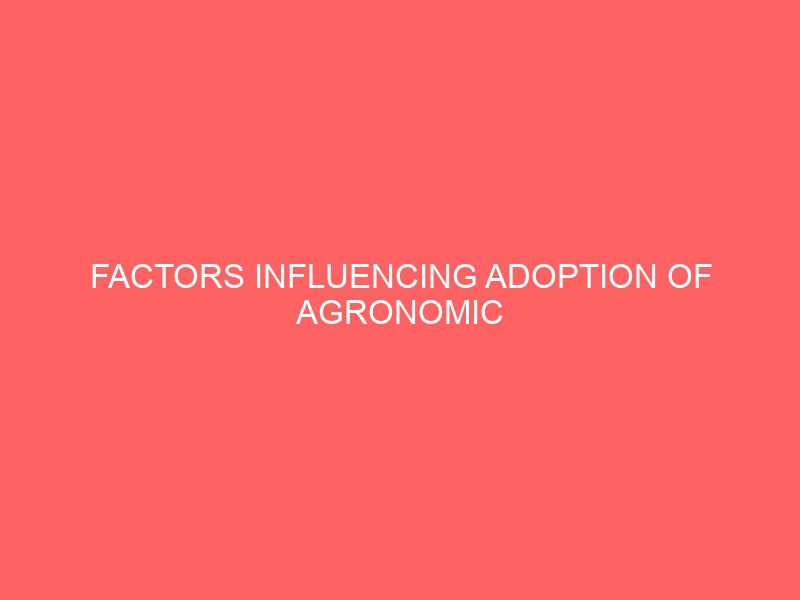Description
THIS REEARCH WORK IS ON FACTORS INFLUENCING ADOPTION OF AGRONOMIC PRACTICES OF NERICA RICE PRODUCTION.
ABSTRACT
This study was conducted to evaluate the factors influencing the adoption of NERICA rice agronomic practices among farmers in three selected Local Government Areas of Kano State, Nigeria. The specific objective were to: Determine the rate of adoption of NERICA agronomic practices; determine factors influencing adoption of NERICA rice; determine the relationship between adoption of NERICA rice and yield, income and level of living of the farmers and identify the constraints encountered by the farmers in adoption of NERICA rice agronomic practice. The study areas were: Tudun Wada, Garin Malam, and Kura. These three Local Government Areas are located between latitudes 110151 N11o 161N and Longitudes 80251E, 8o281E of the equator respectively. A multistage sampling method was employed: Firstly, three LGAs with highest level of NERICA rice production were purposively selected; secondly, two villages were purposively selected on the basis of being the most prominent NERICA rice producing areas from each LGA. Thirdly, 20% of the farmers (548) engaged in NERICA production was randomly selected to get 110 respondents for this study. It was found that 96%of the respondents were males with mean age of 38. About 93% of the respondents adopted NERICA varieties and seed rate; spacing was adopted by 51% and weed control adopted by 63%. Multiple regression analysis revealed that the level of education, age, family size, extension contact, farming experience, access to credit facilities, and membership of the association. Technological characteristic like complexity, and compatibility collectively contributed 46% to the variability in the adoption of NERICA rice agronomic practices. The survey found that 22% of the respondents obtained N31, 000 and above as increase in income due to adoption of NERICA rice. It was also found that 53% of the farmers reported higher cost of fertilizer, 47.3% poor credit facilities, 34% inadequate extension services, 16.4% insufficient agrochemicals as major problems. It was recommended that farmers should be encouraged to adopt agronomic practices as a package to improve their level of production through participation in extension training and advisory services. It was therefore adoption of NERICA rice agronomic practices was found to have significant effects on, yield, income and level of living of the respondents. Based on this success it is hereby recommended that the NERICA rice productions should be scaled up, replicated in other Local Government Areas within the State.
CHAPTER ONE
I NTRODUCTION
1.1 Background to the Study
Rice is regarded as one of the most important cereal grains in many regions of the world and reported to be the most cultivated crop and consumed for more than 10,000 years ago all over the world (World Bank 2001). Total land area under rice cultivation globally was estimated at 150,000,000 hectares with annual mean production of 500,000,000 metric tons that represents 29% of the total output of grain crops worldwide (Tsuboi, 2004, Kuangdi and Guofang, 2003).
Surveys conducted in 2009 by the National Agricultural Research Systems (NARS) and the National Agricultural Statistical Services (NASS) in 21 Sub-Saharan African countries discovered that land area under NERICA rice production was 140,000 hectares in Guinea and 244,000 hectares in Nigeria. Diagne et al. (2006) and Adegbolaet al. (2006) estimated that the total land area under NERICA rice cultivation was 51,000 hectares in Guinea in 2004 and 5,000 hectares in Benin in 2003. The National Food Reserve Agency (NFRA) of Nigeria reported 186,000 hectares under NERICA 1 cultivation in Nigeria in 2007. The Uganda National Agricultural Research Institute, cited from the Statistics Office in the country‟s Ministry of Agriculture that 35,000 hectares under NERICA 4.
Before NERICA rice biotechnology research program was set up in 1991, rice was the staple food crops for more than half of the world‟s population, and some 240 million people in West Africa were dependent on rice as their primary source of food energy and protein (Kijima, et al, 2008).








Reviews
There are no reviews yet.